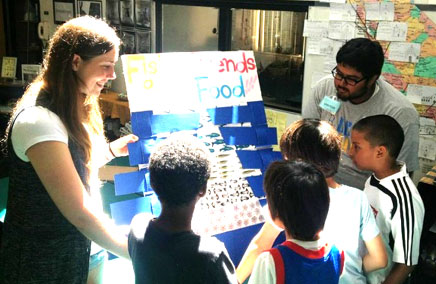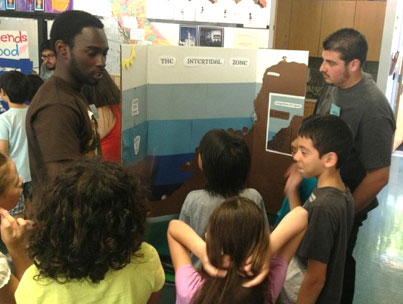| |  |
| UCLA COSIA students teaching kindergarten children using the lessons and materials they developed during the course |
By the time they are Juniors and Seniors, students in the sciences at UCLA have plenty of content knowledge and a valuable set of laboratory and field skills. However, their strong training in science may not have prepared them for one of the fundamental tasks they will be expected to perform throughout their science careers: communicating to non-scientists about their work.
Enter Dr. Rachel Kennison of UCLA, Co-director of COSEE West. In 2012, Dr. Kennison traveled to Berkeley-Lawrence Hall of Science to attend an instructors training workshop for the COSIA (Communicating Ocean Science to Informal Audiences) course. Back at UCLA, she worked with faculty in the sciences to describe the course and its benefits, and encouraged them to tell students about the course. The university agreed to offer the course in spring of 2013, and the result was a full class of undergraduate science majors. As a bonus, four graduate students registered for the course, recognizing its value for their work.
To plan and deliver the course, Dr. Kennison worked in partnership with colleagues at Santa Monica Pier Aquarium, who were enthusiastic about the opportunity to have college students teach their visitors about marine science. During the course, the COSIA students visited the aquarium regularly, first to try out interactive learning activities for themselves and observe visitors in the free-choice learning environment, then to try their own hands at teaching a marine science activity that they developed.
The COSIA students had plenty of expertise in traditional science knowledge but little experience in teaching in an informal situation, or in how people learn and current pedagogical theory. Before they could get to the point where they were confident in teaching, in class, they learned about teaching and learning theory, which was modeled with hands on activities. As they were immediately thrown onto the floor of the Aquarium to begin their practice, the new educators had to engage the learners, find out what they already knew or thought they knew, and share their science concepts in a way that was relevant for the learners. In addition, many of the visitors during the COSIA teaching sessions were only 5 years old, so the COSIA students had to consider what ideas and experiences would make sense for them.
 | |
UCLA COSIA students teaching kindergarten children using the lessons and materials they developed during the course | |
The COSIA students were challenged to create activities that would engage their young visitors, include an interactive component, communicate accurate scientific concepts and information, and confront any misconceptions. Since one of the goals of COSIA is to teach non-scientists to observe and investigate the world around them in the way scientists do, the activities needed to be intriguing enough to provoke questions and include ways for the learners to manipulate the materials to find answers. The COSIA students turned on their creativity and produced a colorful and compelling set of learning activities: a deep sea predator-prey game, complete with bioluminescent fish; a nasty-looking mock algae bloom; a working model showing the process of coral bleaching; a model sea star with tube feet that really stick to the sides of an aquarium; a chemoreception challenge where students had to follow a minty scent to its origin; and a mock intertidal zone with crashing waves where learners could use props to try out different survival strategies.
The COSIA students’ leap into the new world of informal science education turned out to be a great success. “I was nervous about whether I could teach young children,” said COSIA participant Andrea Ho. “But it turned out to be really fun!”
Graduate student Corey Rovzar, “I am rethinking my career path. It will definitely include outreach and education.”
“It was tricky to come up with a good activity that fulfilled all the requirements and would still draw the children over to investigate,” said Binal Patel, who worked with Courtney Van Gorden to create a game about the food pyramid. “We learned a lot about teaching and how to clarify the message we wanted them to get.”
Dr. Kennison praised the COSIA students for their efforts. “In their preparations to teach children and the public about the ocean, the students deepened their own science knowledge and worked hard to make sure the information was clear,” she said. “Many of them surprised themselves and appreciated the opportunity to use skills they didn’t know they had. They also learned about science education and put it into practice. One of the most telling outcomes is that 6 students will continue to volunteer at the Aquarium over the summer.”
For more information about COSIA, visit our website or contact Dr. Rachel Kennison

